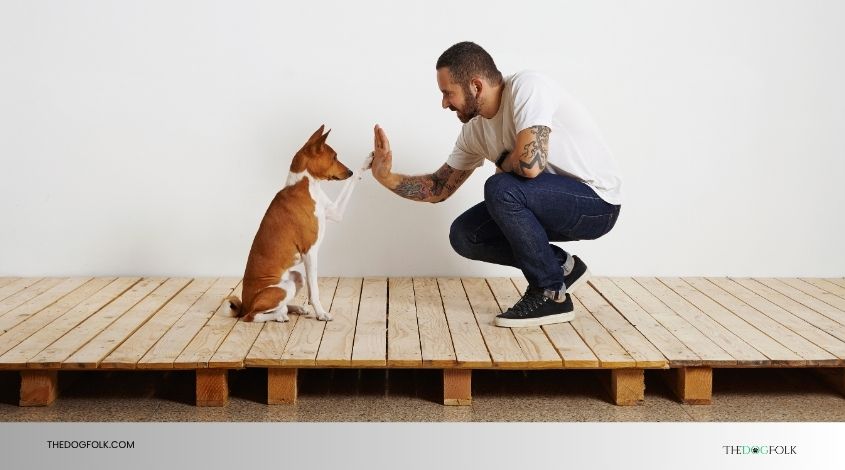Last Updated on September 24, 2025 by Emily Hartman
Imagine coming home to a well-behaved dog who sits calmly by your side, eager to show off their best manners. Training your dog at home might seem daunting, but it doesn’t have to be.
With the right steps, you can transform your playful pup into a disciplined companion, all within the comfort of your living room. This guide will walk you through easy, effective training techniques that truly work. Are you ready to strengthen the bond with your furry friend and enjoy a harmonious home life?
Keep reading to discover how to make your training sessions both fun and successful for you and your dog.

Credit: www.goodreads.com
Contents
Setting Up A Training Environment
Training your dog at home requires a well-structured environment. A good setup enhances learning and keeps distractions at bay. Dogs thrive in spaces tailored for training. It’s essential to prepare a space that promotes focus and comfort.
Choosing The Right Space
Select a quiet area for training. Avoid busy spots where people walk by often. Your living room or backyard can work well. Ensure the space is safe with no sharp objects around. Dogs need room to move freely. A spacious area helps them stay engaged.
Gathering Essential Tools
Collect tools that aid training. Treats are great for rewarding good behavior. A clicker helps in marking actions. Leashes and collars are vital for control. Toys keep your dog interested and motivated. Ensure everything is within reach.

Credit: sally-hutchins.com
Basic Commands And Techniques
Training your dog at home can be a rewarding experience. Starting with basic commands and techniques lays a strong foundation. These commands help enhance communication with your furry friend. They also ensure safety and build mutual trust.
Sit And Stay
The sit command is often the first trick taught. Hold a treat close to your dog’s nose. Move your hand up, letting their head follow the treat. This will naturally cause their bottom to lower. Once in a sitting position, reward them with the treat. Use a cheerful voice to say “sit.” Practice several times a day. The stay command follows sit. Ask your dog to sit, then open your palm facing them. Use the word “stay.” Take a few steps back, maintaining eye contact. Return quickly and reward them if they stay put.
Come And Leave It
The come command is crucial for safety. Use a leash at first. Call your dog’s name followed by “come.” Encourage them with praise when they approach. Reward them with a treat. Practice this in different settings. The leave it command prevents unwanted behavior. Place a treat in both hands. Show one hand and say “leave it.” When your dog stops trying to get it, reward them from the other hand. Repeat until they understand.
Positive Reinforcement Methods
Positive reinforcement encourages good behavior with rewards. It can be treats, praise, or play. Consistency is key to success. Reward your dog immediately after they follow a command. This helps them associate the behavior with the reward. Avoid punishment methods. They can lead to fear or aggression. Keep training sessions short and fun. This maintains your dog’s interest and enthusiasm.
Advanced Training Tips
Training your dog at home can be a rewarding journey for both you and your furry friend. While basic commands lay the groundwork, advancing to more sophisticated skills can elevate your dog’s behavior and deepen your bond. Advanced training is not just about teaching tricks; it’s about enhancing communication and understanding between you and your dog. Ready to take your dog’s training to the next level? Let’s dive into advanced tips that will refine your dog’s skills and address any behavioral challenges.
Socialization Skills
Socializing your dog is crucial for their development and happiness. Start by introducing them to various environments, people, and other animals. This exposure helps reduce fear and aggression. Consider visiting dog parks or arranging playdates with friends’ pets.
Observe how your dog interacts and adjust your approach based on their reactions. Praise them for positive interactions and gently guide them through any anxious moments. Socialization is an ongoing process. The more you expose your dog to new experiences, the more adaptable they become.
Have you noticed a change in your dog’s behavior when meeting new people? It’s fascinating how a simple socialization routine can boost their confidence!
Handling Behavioral Issues
Every dog has unique behavioral quirks. Tackling these issues requires patience and consistency. Identify the root cause of the behavior—whether it’s anxiety, boredom, or lack of exercise. Once you understand the trigger, you can address it more effectively.
For instance, if your dog barks excessively, it might be due to boredom or a need for attention. Increase their playtime and engage them with interactive toys. Redirect their focus with commands like “sit” or “stay” when they begin barking.
Are you struggling with a stubborn behavior? Sometimes, involving a professional trainer for specific issues can be invaluable. They offer insights that you might not have considered.
Training your dog at home is a dynamic process. Keep experimenting with different techniques and observe how your dog responds. Remember, every dog learns at their own pace, so patience is key. What’s your biggest challenge with advanced dog training? Sharing your experiences can help others facing similar hurdles.

Credit: www.amazon.com
Creating A Consistent Routine
Developing a daily schedule helps dogs learn faster and feel secure. Consistent routines make training at home easy and fun. Use the same commands and rewards every day to build good habits.
Creating a consistent routine is key to successful dog training at home. Dogs thrive on structure and repetition. This helps them understand what is expected. A reliable routine can make learning easier for your pet. It builds trust and reduces stress. Establishing daily habits ensures progress. This also strengthens your bond with your furry friend.
Daily Practice Sessions
Short practice sessions work best. Aim for 10 to 15 minutes daily. This keeps your dog engaged and prevents boredom. Choose a quiet space free from distractions. Consistency is important. Use the same commands each time. Reward good behavior with treats or praise. Gradually introduce new skills. Patience is crucial. Every day is a chance to learn.
Tracking Progress And Adjustments
Keep track of your dog’s progress. Note their strengths and areas needing improvement. Adjust routines if necessary. Some dogs learn faster than others. Be flexible. Consider your dog’s mood and energy levels. Celebrate small victories. Change methods if needed. This keeps training effective and enjoyable.
Frequently Asked Questions
What Are The First Steps To Train A Dog At Home?
Start with basic commands like sit, stay, and come. Use treats as rewards. Be patient.
How Long Should Dog Training Sessions Last?
Keep sessions short. About 10 to 15 minutes. This keeps your dog focused and interested.
Can I Train My Dog Without Professional Help?
Yes, you can. Use online resources and books. Consistency and patience are key to success.
What Is The Best Age To Start Dog Training?
Begin as early as eight weeks. Early training helps develop good habits and social skills.
How Do I Correct Bad Behavior In My Dog?
Use positive reinforcement. Redirect their attention. Consistently reward good behavior to encourage change.
Conclusion
Training your dog at home can be a rewarding experience. Start with basic commands. Use treats and praise as motivation. Be patient with your dog. Consistency is key for success. Practice daily, but keep sessions short. Avoid frustration; it only confuses your dog.
Celebrate small victories together. Your bond will strengthen with time. Keep learning new techniques. Stay positive and enjoy the journey. Remember, each dog learns at their own pace. You can do it, and so can your dog! Keep practicing and watch your furry friend flourish.

Emily Hartman is a lifelong dog lover, writer, and canine care enthusiast. With years of experience in pet parenting and a deep passion for helping others raise happy, healthy dogs, she shares practical tips, thoughtful advice, and product recommendations to make life better for pups and their people. When she’s not writing, you’ll find her hiking with her rescue lab, Milo, or exploring new dog-friendly spots around town.

